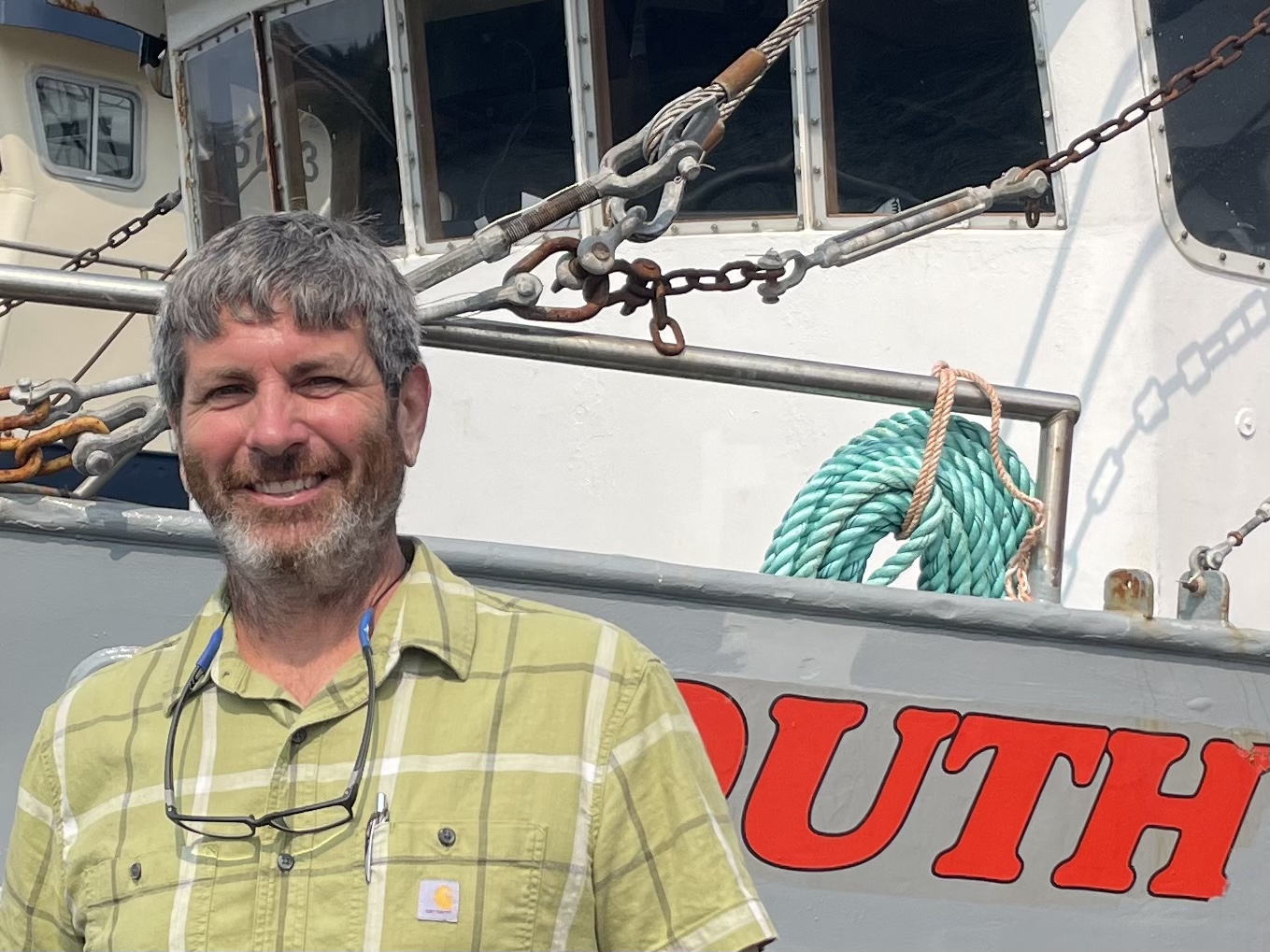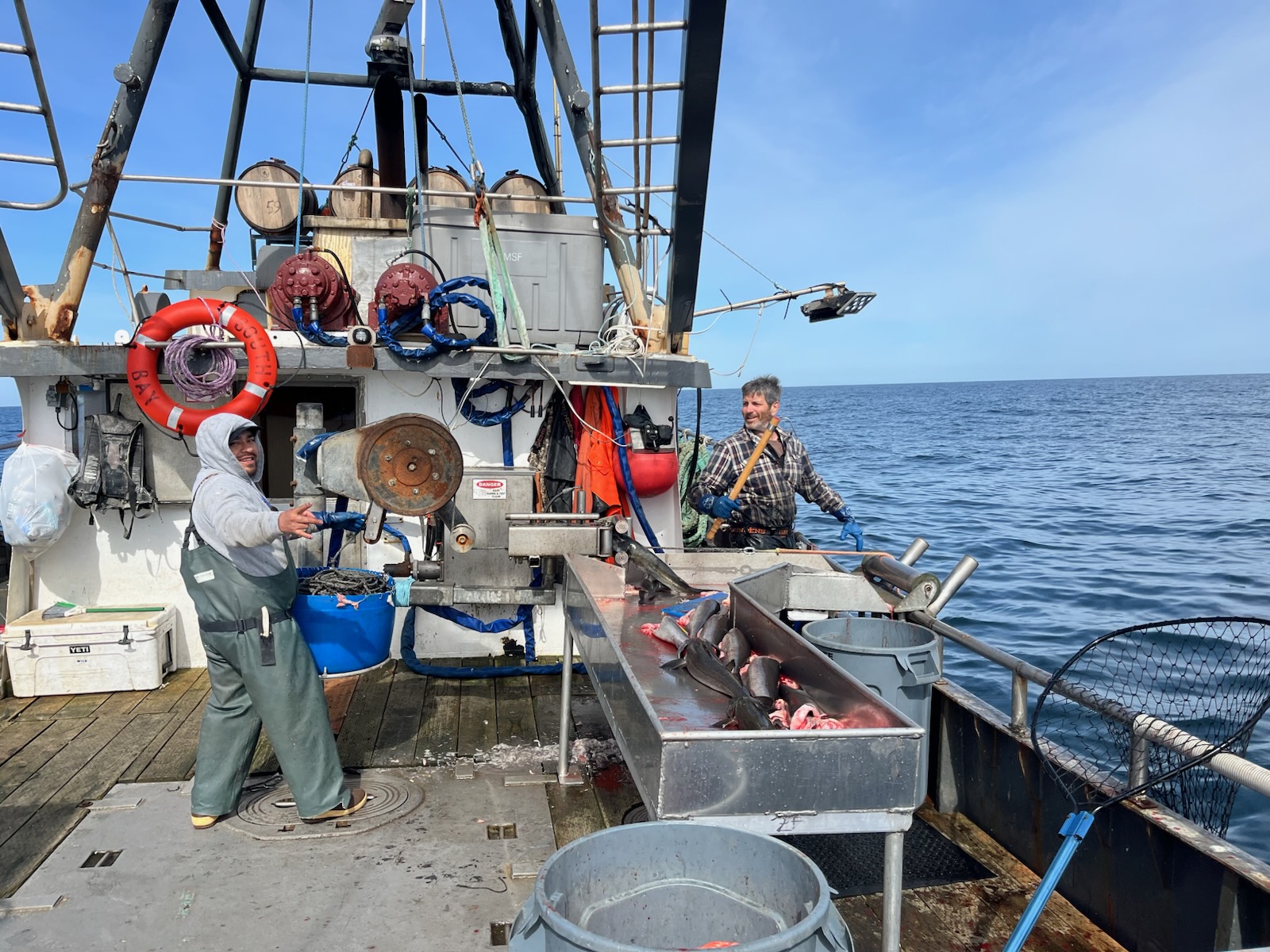In honor of National Travel and Tourism Week [May 4-10], we’re celebrating the community partners making waves in sustainable, resilient tourism across the Oregon Coast.


“Hang on,” Rob tells me, just as he launches into a story about his life on the water. “I’ve got a farmer here to pick up some fish guts. Can I call you right back?”
Such is a day in the life of Rob Seitz—a commercial crabber and fisherman out of Astoria, Oregon, who is looking to the future of what the fishing industry could be.
Along with championing the Astoria Fishermen’s Co-op, Rob owns and operates South Bay Wild Inc., a small, family-run fishing vessel committed to sustainable harvest practices and triple-bottom-line values: people, planet, and profit. He and his wife also run South Bay Wild Fish House, where their two kids work alongside them.
Rob has been on the water for over 30 years, including time spent creating a community fishery project in Central California. He’s now firmly embedded in the fabric of Astoria as a port town—and as someone with a foot in both the fishing and tourism industries, Rob has an important perspective on their prospective futures.
Some days Rob is on the water, some days he’s delivering fish, and others he’s bussing tables and chatting with customers who—as it turns out—are always interested to learn where their fish is coming from.
“Yesterday we delivered some longline fish here in Astoria,” he says. “We sent some to a big processor, but kept some for our restaurant and a few other local restaurants. I spent the day getting it filleted and dropped it off around town.”
This kind of direct marketing is exactly why Rob helped start a new fishers’ cooperative in Astoria—formed just over a year ago with the goal of reclaiming control over dock space and seafood pricing. The structure allows fishermen to collectively manage and promote their fishing operations, and pool resources such as equipment, processing facilities, and marketing efforts so they can access larger markets, reduce individual costs, and gain a stronger bargaining position when negotiating with buyers and suppliers.
“I got started doing direct marketing out of frustration,” Rob says. “We have a product that’s worth more than what we’re getting for it, but striking doesn’t work—it just creates animosity. The best way to influence price is to market it ourselves.”
He’s seen firsthand how competition for crab—one of the last fisheries where fishers are making money—has driven better pricing, especially as live buyers can purchase across docks. “It’s one of the only fisheries where that dynamic has really worked in our favor.”
There was a time when kids were told, “Do anything but fishing.” Rob remembers the late ‘90s groundfish disaster, the buyback program that cut fleet size, and the shift to IFQ (Individual Fishing Quota) systems that left many owner-operators behind. “But we’re through that now. And I’m encouraged that people like you [OCVA] and others are taking an interest and putting effort behind more change.”
When the Port of Astoria issued a call for waterfront redevelopment ideas, the co-op stepped up with a request: dock space for local fishers. Somewhere to offload fish and sell directly. Somewhere that protects fishing heritage and gives community members a stake in the future. The Port agreed to stipulate that any future developer work with the co-op, regardless of who gets the bid.
This kind of decision—one that centers the voices of working fishers and small businesses—is exactly what Rob hopes to champion more of. This spring, he’s running for a seat on the Port Commission, driven by the belief that those who depend on the waterfront for their livelihood should have a say in how it’s shaped.
“When I gave a presentation to the Port Commission, I told them about when I first came to town in ’93. I was delivering at the Astoria Dock, which is now Pier 39. Ocean Foods was where the Bowline Hotel is now.”
This transformation of working waterfront into real estate and recreation is part of what fuels Rob’s belief that fishing and tourism shouldn’t compete—they should partner.
At his restaurant, he talks with the patrons–locals and visitors. “People want to see fish offloading,” he says. “They’re interested. They want to feel connected to what they’re eating.”
People want to see fish offloading. They’re interested. They want to feel connected to what they’re eating.
Rob Sietz
It’s this kind of grounding in his community—with roots in fishing, in service, and in tourism—that gives him hope for how we might better partner as a region for the future of these industries, which rely on each other for a resilient coastal economy.
While he busses tables, he chats with guests and shares lessons from a life on the water—but he also shares his stories with the community as a long-time participant in the FisherPoets Gathering, where he’s performed every year except the first.
“At first, we joked that a poetry festival must be a sure sign you’re in a dying industry,” he says. “But it turns out it wasn’t a eulogy. It’s a celebration—and like a family reunion. I get to see people there I don’t see the rest of the year.”
While he knows the road ahead is long, Rob remains firmly planted in Astoria, where his efforts are setting the example of what a collaborative economic future can look like. Fishing and tourism in symbiosis is the way forward, and he’s optimistic that the world seems to be taking an interest in this approach.
About Rob Seitz:
Rob Seitz is a lifelong commercial fisherman and the co-owner of South Bay Wild Inc. and South Bay Wild Fish House in Astoria, Oregon. With over 30 years of experience on the water, he is also an advocate for sustainable fishing practices and community-led economic development. In addition to his work in the fishing and tourism industries, Rob is a beloved participant in the FisherPoets Gathering, where he shares his experiences through poetry. Below is an excerpt from one of Rob’s poems:
Paint’s cheap,
for a hundred dollars a can
you can turn the old new again,
a two-part epoxy face lift.
One pass of the roller-
blemishes and imperfections disappear. With the
proper amount of prep-work dull and cracked will become smooth and
shiny. Let the needle-scaler chip away at the problem areas.When you’re done painting
It’s important to step back and
admire your work. Take a minute to appreciate the
freshly painted perfection of your net-reel, say. Because,
you know as soon as you use it, it will begin its slow path of degradation
back to the state that caused you to paint it
in the first place.But for that moment,
let those things you can’t control slip away, because maybe you cant
change the weather, or fishery politics, and maybe
your bouts with optimism are less frequent
these days…
but, right now
your net-reel is flawless.